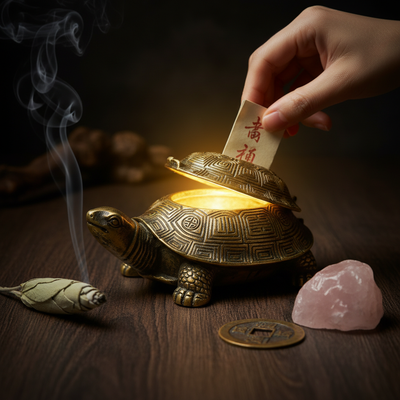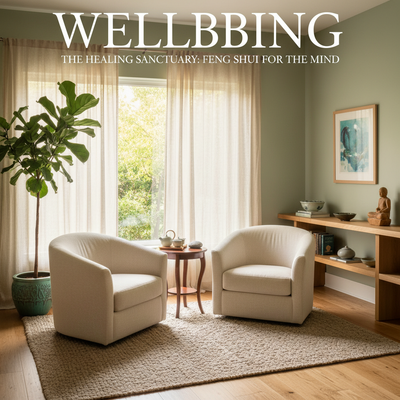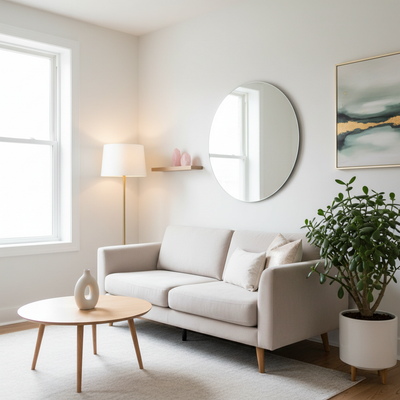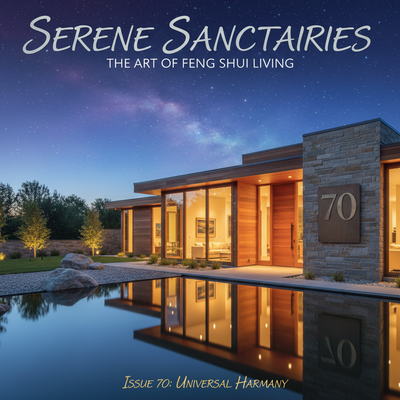Let's tackle the main question right away: is a basement bedroom naturally bad for feng shui? Most people think it is. These underground spaces are often linked with darkness, dampness, and heavy, low energy—all things that go against a lively, healthy life. We've worked with many clients who feel tired, stuck, or uninspired in their below-ground rooms, and their worries make sense.
However, the answer isn't simply "yes." While a basement brings special energy challenges, it's definitely not a feng shui curse. Think of it as a blank canvas with a different feel. With the right knowledge and smart planning, you can change a draining basement bedroom into a supportive, grounding, and deeply caring safe space. It's not about fighting against what the space naturally is, but about skillfully balancing it. This guide will walk you through that exact process. We will first figure out the main energy problems, give you a powerful set of important fixes, lay out a step-by-step change plan, and finally, show you what common mistakes to avoid. Your journey to a thriving basement bedroom starts now.
The Core Challenge

To solve a problem, you must first understand it. The uneasiness you might feel in a basement bedroom isn't just in your head; it's based on basic feng shui ideas that are challenged by a below-ground space. By recognizing these main issues, you can validate your feelings and begin to apply targeted, effective solutions. This is the diagnosis phase, moving from a vague sense of "something's wrong" to a clear understanding of the energy landscape.
Too Much Yin Energy
In feng shui, all energy is a dance between two opposing but complementary forces: Yin and Yang. Yang energy is active, bright, warm, and expansive—the energy of the sun, daytime, and outward activity. Yin energy is passive, dark, cool, and inward—the energy of the moon, nighttime, and rest. A healthy home has a balance of both. A basement, by its very nature of being below ground, dark, and cool, is overwhelmingly dominated by Yin energy. While Yin is essential for a bedroom (promoting rest), too much of it can lead to tiredness, depression, and a lack of motivation. The goal is not to get rid of Yin, but to bring in enough Yang to create a harmonious balance.
Sinking or Still Qi
Qi (pronounced "chee") is the invisible life force energy that flows through everything, including our homes and our bodies. For the best health and vitality, Qi should flow smoothly and gently, like a winding stream. In a basement, the energy has a natural tendency to sink and become still. Being physically below the main ground level can create an energy pattern of "sinking," which can match a dip in your personal vitality, career momentum, or overall mood. Furthermore, poor air circulation and a lack of natural entry/exit points for energy can cause Qi to pool and become stagnant, much like still water, leading to feelings of being stuck or uninspired.
Disconnection from Nature
Humans are naturally wired to connect with the cycles of nature. A view of the outdoors and the presence of natural light are fundamental to our well-being. They provide vital Yang energy and keep our internal clocks (circadian rhythms) in sync. A basement bedroom severely limits this connection. The absence of a window with a view of the sky, trees, or a garden can lead to a sense of isolation and disconnection. This lack of natural light is one of the most significant feng shui challenges in a basement, directly impacting mood, energy levels, and even sleep quality.
The Threat of Dampness
Basements are well-known for being prone to dampness, moisture, and mustiness. From a practical standpoint, this can lead to mold and poor air quality, which are obvious health concerns. From a feng shui perspective, dampness is a physical sign of stagnant, unhealthy Yin energy. It creates a heavy, oppressive atmosphere that can weigh down your personal energy and block the healthy flow of Qi. Basements are also frequently used for storage, making them magnets for clutter. Each stored item that is not used or loved contributes to the energy stagnation, making the space feel even more cluttered and blocked.
7 Essential Cures
Now that we've diagnosed the challenges, we can move to the solutions. This is the practical heart of your transformation. These seven essential cures are designed to directly counteract the heavy Yin energy and stagnant Qi of a basement, turning it into a space that supports and revitalizes you.
1. Master the Light
Light is your number one priority. It is the most powerful tool for bringing in Yang energy and lifting the Qi of the entire room. Your goal is to copy the qualities of natural sunlight as much as possible. Start by replacing all standard bulbs with full-spectrum light bulbs. These bulbs are designed to replicate the full range of the natural light spectrum, which can improve mood and reduce eye strain. Next, use uplighting to visually and energetically "lift" the ceiling. Torchiere-style floor lamps that shine light upwards are perfect for this, as they counteract the sinking feeling of being underground. Finally, strategically place mirrors to amplify and circulate the light you have. A large mirror placed on a wall that can reflect a lamp or a light-colored wall will make the room feel brighter and more expansive. Just be sure to avoid placing a mirror directly facing your bed, as this can disrupt sleep.
2. Use Color Psychology
Color is a form of energy with a distinct frequency, and it has a profound impact on our psychology and the room's energetic feel. In a basement, you need a color scheme that both expands the space and provides a sense of stability. Avoid dark, heavy colors that will only enhance the Yin energy. Instead, opt for a two-part approach. Use light, airy colors on the walls to create a sense of spaciousness and light. Soft whites, very light blues, and pale sage greens are excellent choices. Then, bring in grounding earth tones to add stability and warmth, preventing the space from feeling sterile or cold. These colors connect to the Earth element, which provides security.
| Color Category | Examples | Feng Shui Purpose |
|---|---|---|
| Energizing & Expanding | Soft White, Light Sky Blue, Pale Green, Cream | Creates a sense of openness, mimics daylight, lifts Qi. |
| Grounding & Stabilizing | Sandy Beige, Warm Terracotta, Soft Yellow, Earthen Tan | Provides stability, security, and a connection to the Earth element. |
3. Breathe Life into the Room
Still air equals still Qi. Improving air quality and flow is critical. A high-quality dehumidifier is essential in most basements to combat dampness, the physical form of negative energy. An air purifier will further help to remove dust, allergens, and energetic debris. Beyond technology, bring in the real thing: life. Adding plants is one of the best ways to introduce vibrant life force energy (Sheng Qi) into a room. They also naturally purify the air. Choose low-light tolerant plants like the Snake Plant (Sansevieria), which has an upward-growing energy, or the ZZ Plant (Zamioculcas zamiifolia), known for its resilience and air-purifying qualities.
4. Anchor the Energy
Because a basement is already "in" the earth, it might seem counterintuitive to add more of the Earth element. However, the energy of a basement is often unstable and sinking, whereas the feng shui Earth element provides stability, grounding, and nourishment. It acts as an anchor. You can introduce this element through several means. Use items made from clay or ceramic, such as pottery and planters. Incorporate square shapes, which are the symbolic shape of the Earth element; this can be a square rug, ottoman, or even patterns on your bedding. Finally, hang imagery of stable, beautiful landscapes—think rolling hills or a peaceful desert scene, not a dramatic mountain peak—to bring that grounding energy into the room.
5. Define Your Entrance
A basement bedroom can sometimes lack a clear, defined entrance, making it feel more like a cave than a personal sanctuary. Energetically, this blurs the transition from the outer world to your private space. You must create a clear threshold. This doesn't require construction. Simply placing a high-quality, welcoming rug just inside the doorway to your room creates a distinct landing spot. Ensure this entry point is well-lit, perhaps with a dedicated lamp or a brighter overhead light. For a more defined separation, you could even use a beautiful decorative screen near the entrance to create a mini-foyer effect. This simple act tells the energy (and your subconscious) that it is now entering a special, protected space.
6. Choose Uplifting Imagery
The art and imagery you surround yourself with are constantly communicating with you on a subconscious level. In a subterranean room, it is vital that your artwork counteracts the physical reality of your location. Avoid dark, moody, or downward-trending art. Instead, choose art that depicts expansive, open, and sunny scenes. Think of a painting of a wide-open sky with fluffy clouds, a photograph of a sun-drenched beach, or botanical prints of flowers and trees reaching upward toward the sun. This imagery acts as an "energetic window," visually and psychologically lifting your spirits and the energy of the room.
7. Secure the Commanding Position
The commanding position is one of the most important principles in all of feng shui, especially for a bedroom. It relates to your sense of safety, command, and control over your life. To be in the commanding position, your bed must be placed so that you can see the door to the room without being in a direct line with it. This usually means placing the bed diagonally opposite the door. This layout allows you to see who or what is entering your space, which puts your nervous system at ease and allows for deeper, more restorative rest. It is also crucial to have a solid headboard, which symbolizes support and stability in your life. Place the headboard securely against a solid wall for maximum benefit.
The Energy Transformation Blueprint
Knowing the cures is one thing; implementing them effectively is another. To prevent overwhelm, we've developed a systematic, 5-step action plan. This blueprint transforms a list of tips into a manageable project, ensuring you build a strong energetic foundation layer by layer.
Step 1: The Foundational Cleanse
Before you can invite in new, positive energy, you must clear out the old. This first step is non-negotiable and has two parts. First, perform a ruthless physical decluttering. Basements are magnets for storage and forgotten items, each one holding stagnant energy. Go through everything and be honest about what you need, use, and love. Donate, sell, or discard the rest. Follow this with a deep cleaning. Wipe down walls, clean the floors, and wash all linens. Second, perform an energetic space clearing. This clears away any residual heavy or negative energy. Simple methods include smudging with sage (with a window or door open for ventilation), ringing a bell or a singing bowl in all corners of the room, or wiping down surfaces with a simple salt water solution.
Step 2: The Illumination Phase
With the space cleared, your next focus is light and air. This phase is about fundamentally shifting the dominant Yin energy. Go through the room and implement the lighting cures from the previous section. Swap out all your old light bulbs for full-spectrum bulbs. Purchase and position your uplighting lamps to raise the ceiling's energy. Strategically hang your mirrors to bounce and amplify the light. At the same time, set up your dehumidifier and air purifier. This is the phase where you literally and energetically bring light and fresh breath into the space, forming the second layer of your transformation.
Step 3: The Anchor & Command Phase
Now that your room is clean, clear, and bright, it's time to arrange the most important piece of furniture: your bed. This step is about establishing your personal power and stability within the space. Move your bed into the commanding position, where you can see the door but are not directly in line with it. Ensure it has a solid headboard and that it is placed firmly against a wall. Once the bed is set, arrange your other main furniture, like a dresser or a desk, to support this layout and create a harmonious, easy-to-navigate flow. This anchors you in the room and sets the foundation for a feeling of safety and control.
Step 4: The Activation Phase
The foundation is now set. The room is bright, the air is fresh, and your bed is in a powerful position. Now, you will activate the space with life and stability. This is where you layer in your chosen color palette. If you decide to paint, do it now. Bring in your bedding, rugs, and pillows in the light, airy, and grounding earth tones you selected. Next, consciously introduce the Earth element cures. Place your ceramic pots, add a square-shaped rug or ottoman, and arrange any other grounding items. This phase is about layering in the elements that will stabilize and nourish the newly lifted energy.
Step 5: The Refinement Phase

This is the final, personal layer of transformation. Your room is now energetically balanced and supportive. The final step is to make it uniquely yours. Hang your carefully selected uplifting artwork that acts as your "energetic window" to the outside world. Place personal photos and cherished objects that bring you joy and evoke happy memories. This is what turns a well-designed room into a true sanctuary. This phase completes the journey, refining the space so it not only follows good feng shui principles but also deeply reflects and supports your individual spirit.
A QI FLOW Team Case Study
Theory is helpful, but seeing these principles in action provides true clarity. This is where our first-hand experience at THE QI FLOW team can illustrate the profound impact of a strategic feng shui intervention.
The Challenge: A Draining Space
We were contacted by a university student, Alex, who felt constantly fatigued and uninspired. His basement bedroom in a shared house had become a place he dreaded. The room was dark, had a persistent musty smell, and his desk faced a blank wall, making studying a chore he consistently avoided. He reported poor, restless sleep and a general feeling of being "stuck" in his academic and personal life. The energy was so low that he often chose to study in the noisy campus library rather than his own room.
THE QI FLOW Team's Assessment
Our on-site assessment revealed classic basement issues that were creating a significant energy drain. The Qi was critically low and stagnant, made worse by clutter and poor ventilation. We identified a major issue: his bed was positioned directly under a large, exposed ceiling pipe. In feng shui, this creates an oppressive energy known as "sha qi" (attacking energy), which can feel like a constant weight or pressure, leading to headaches and troubled sleep. Furthermore, the room had a severe lack of the Fire element, the element associated with passion, inspiration, and recognition.
The Implemented Solutions
THE QI FLOW team created a tailored, multi-step plan for Alex that was both effective and budget-friendly. First, to address the oppressive pipe, we had Alex paint it the exact same color as the ceiling. This simple act made the pipe visually "disappear," immediately reducing its energetic pressure. Second, we worked with him to reposition his bed into the commanding position, diagonally opposite the door. We also had him add a simple, solid wood headboard for support, which we sourced from a second-hand store. Third, we completely transformed the lighting. We introduced a combination of full-spectrum uplighting and a beautiful Himalayan salt lamp on his nightstand. The salt lamp is a fantastic cure as it introduces both the warming Fire element (from the light) and the grounding Earth element (from the salt crystal). The color palette was shifted from a drab gray to a warm, sandy beige to ground him and make the space feel more nurturing.
The Result: A Vibrant Sanctuary
The transformation was remarkable. Within weeks, Alex reported a dramatic shift. He was sleeping more soundly through the night and waking up feeling refreshed for the first time in months. He felt more energized and clear-headed during the day and found it significantly easier to focus on his studies at his desk (which we had moved to face the open room). The room no longer felt like a drain but a supportive "home base" that nurtured his well-being and academic success. It became his personal sanctuary for rest and focus.
5 Common Mistakes to Avoid
As you apply these cures, it's just as important to know what not to do. Avoiding these common pitfalls will ensure your positive efforts aren't accidentally sabotaged.
- Mirrors Directly Facing the Bed: A mirror reflecting the bed is thought to amplify energy, which can be disruptive to the restful Yin energy needed for sleep. It's also believed to "invite" a third party into the relationship. Keep mirrors away from the bed's direct line of sight.
- Overhead Beams or Pipes: As seen in our case study, sleeping under an exposed beam, soffit, or large pipe creates "sha qi" or oppressive energy. This can manifest as pressure, headaches, or a feeling of being weighed down. If you cannot move the bed, paint the beam the same color as the ceiling to minimize its visual and energetic impact.
- Water Features or Imagery: While fountains and images of water are often excellent feng shui cures, they are generally not recommended for a basement bedroom. Here, the Five Elements cycle is critical: Water extinguishes Fire. A basement is already dominated by cool, damp Yin energy (associated with Water) and desperately needs the warmth and light of the Fire element. Adding more water energy can worsen feelings of coldness, dampness, and emotional instability.
- Clutter Under the Bed: The space under your bed should be open and clear to allow Qi to flow freely around your body as you sleep. Using it for storage, especially for emotionally charged items or sharp objects, creates stagnation right underneath you. This can lead to blocked energy and restless sleep. Keep it clear.
- Ignoring a Small Window: It's tempting to cover a small, high basement window, but this is a mistake. Cherish every bit of natural light you can get. Keep the window glass impeccably clean and choose window treatments that can be opened fully during the day to allow maximum light and air to enter. Never block your connection to the outside world, no matter how small.
Your Basement, Your Sanctuary
A basement bedroom is not a feng shui sentence to a life of low energy. As we've explored, it is an environment with a unique set of energetic characteristics that simply require a mindful and strategic approach to balance. The challenges of heavy Yin energy, sinking Qi, and a disconnection from nature are real, but they are also entirely solvable.
By focusing on the three most critical pillars of transformation—mastering Light, ensuring fresh Air and flow, and securing the Commanding Position—you lay a powerful foundation for a supportive space. From there, layering in color, grounding elements, and uplifting art turns the room from a functional space into a personal sanctuary. Your basement doesn't have to be a place you tolerate; it can become a source of profound grounding, stability, and restful energy that supports every other area of your life. It can be the very foundation from which you thrive.








0 comments